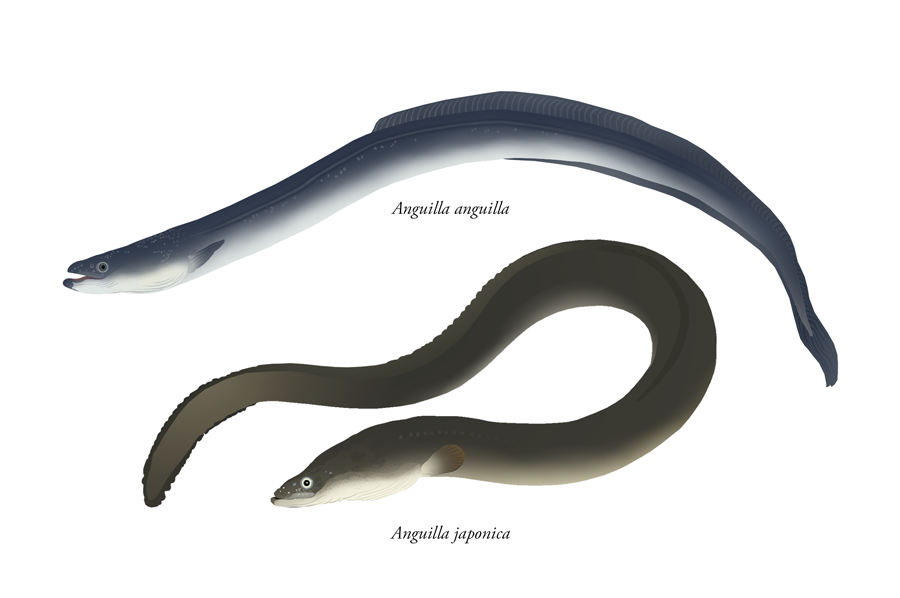European eel (Anguilla anguilla) and Japanese eel (Anguilla japonica), two of the species with sequenced genomes that you can get from my collection of illustrations. Hi-res and web-ready files available here: Illustrations - Shared folder.
Like the arowanas, eels diverged early in teleost fish evolution, and can therefore offer a “snapshot” into the processes that occurred during this time. Teleost fishes are characterized by an early whole genome duplication that happened in a common ancestor approximately 350 million years ago. This was followed by a period of approximately 80-100 million years where teleost genomes were intensely rearranged, with pieces of chromosomes fusing, breaking apart and changing places, perhaps as a direct consequence of the genome duplication. By studying eel genomes, we have a much clearer view of this process (1).
Eels have also kept and found uses for some remnants of this early evolution that other teleost fishes have lost. Hox genes guide the development of the body plan in most animals, whether they are fruit flies, jellyfishes, humans or teleost fishes. All teleosts have kept some duplicated Hox genes that resulted from their ancient whole genome duplication, but eels kept all the duplicated Hox genes (2). This might be part in explaining why eels have such a different body plan and development compared with other teleosts. Eels go through a complex process of metamorphosis during their lives, including several larval stages and, in many species, a long migration from the oceanic spawning grounds up to rivers and streams and then back out into the sea.
This complex development has also made eels extra sensitive to climate change and the disruption or disappearence of their environments. It doesn’t help that many of them also are traditional food sources. The Japanese and American eels are classified as endangered by the IUCN, while the European eel is considered critically endangered.
1) Kai, W. et al. (2014) A ddRAD-based genetic map and its integration with the genome assembly of Japanese eel (Anguilla japonica) provides insights into genome evolution after the teleost-specific genome duplication. BMC Genomics, 15(1), 233. DOI: 10.1186/1471-2164-15-233
2) Henkel, C. et al. (2012) Primitive Duplicate Hox Clusters in the European Eel’s Genome. PLoS ONE, 7(2), e32231. DOI: 10.1371/journal.pone.0032231
Notes
creaturedeityendless liked this
tawnycide reblogged this from egosumdaniel
tawnycide liked this
 johnmyersart reblogged this from scientificillustration
johnmyersart reblogged this from scientificillustration sanssouciavecmoi reblogged this from scientificillustration
shadow-wasser reblogged this from speculative-evolution
 a-golden-bear reblogged this from speculative-evolution
a-golden-bear reblogged this from speculative-evolution sinistarofficial liked this
lostboyriot liked this
jaegerpilotmax liked this
fish-dad reblogged this from speculative-evolution
 sommer-rain liked this
sommer-rain liked this the-raz liked this
iamtheaardvark reblogged this from demi-shoggoth
iamtheaardvark liked this
columbojumpscare liked this
ihavenoshane reblogged this from speculative-evolution
faustandluce liked this
v-v-animals reblogged this from speculative-evolution
hazeweb liked this
demi-shoggoth reblogged this from speculative-evolution
speculative-evolution reblogged this from admantus
hypostomus reblogged this from scientificillustration
nangoat reblogged this from scientificillustration
thatstaroverthere liked this
rocketeeringthecosmos liked this
 johnmyersart liked this
johnmyersart liked this dammar liked this
 jkugler liked this
jkugler liked this andysgra liked this
senoritafish liked this
 ithelonelywolfblr liked this
ithelonelywolfblr liked this fvelsspe liked this
colorfulbunny liked this
alihsi liked this
alittlebitgoesealongways liked this
weredrakka liked this
iiiridium reblogged this from admantus
 admantus reblogged this from scientificillustration
admantus reblogged this from scientificillustration  admantus liked this
admantus liked this  nyamdhal liked this
nyamdhal liked this thisiscompletelyboring reblogged this from scientificillustration
egosumdaniel posted this
- Show more notes


